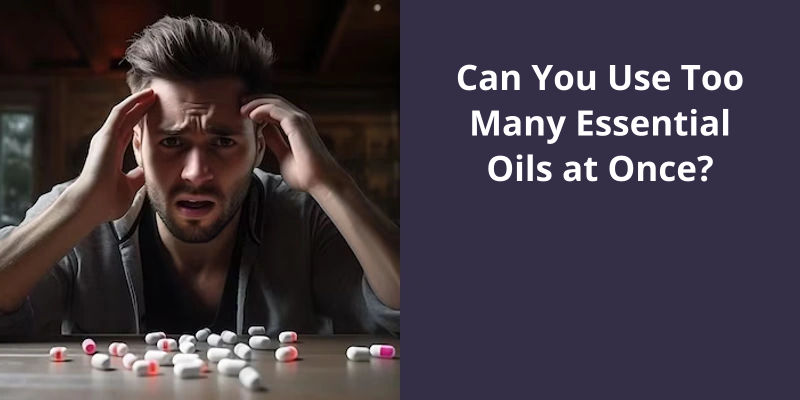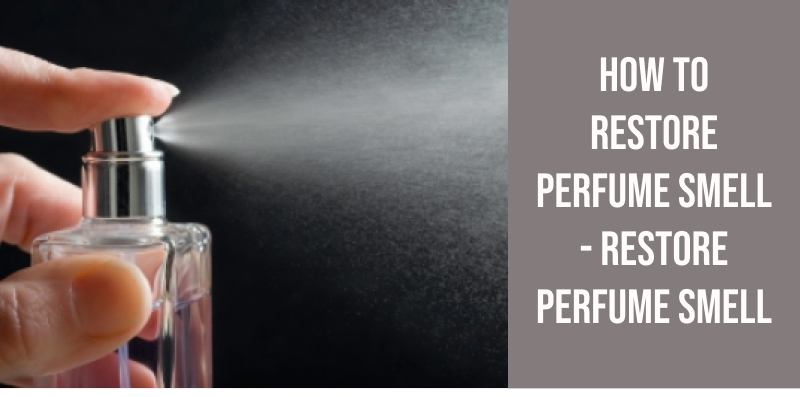Using too many essential oils at once can be detrimental to your health and well-being. While essential oils have many therapeutic benefits, it’s important to remember that they’re highly concentrated substances and require caution and moderation in their use. Overloading on essential oils can lead to skin irritations, allergies, headaches, nausea, and even respiratory issues. It’s crucial to follow proper guidelines and consult with a qualified aromatherapist or healthcare professional to ensure safe and effective use of essential oils.

Can You Use Multiple Essential Oils at Once for Skin?
However, it’s important to note that using too many essential oils at once can be overwhelming for the skin and may cause adverse reactions. It’s recommended to use a maximum of three essential oils in a blend to avoid any potential issues.
When combining essential oils, it’s crucial to consider their individual properties and potential interactions. Some essential oils may have similar effects or chemical constituents, while others may have conflicting properties. Researching and understanding the oils you plan to use is essential to create a safe and effective blend.
It’s also important to note that different individuals may react differently to essential oils. What works for one person may not work for another, so it’s recommended to perform a patch test before using any new blend on a larger area of the skin.
In general, it’s best to start with a small number of essential oils and gradually experiment with different combinations to find what works best for your skin. It’s also advisable to consult with a qualified aromatherapist or skincare professional for guidance and advice on using essential oils for your specific needs.
However, it’s important to do thorough research, consider individual properties and interactions, and use caution to avoid any potential adverse reactions. Using a limited number of oils and performing patch tests are also recommended. Consulting with a professional is always a good idea to ensure safe and effective use of essential oils.
It’s important to approach the topical use of essential oils with caution due to their potency. Instead of applying a single large dose at once, it’s recommended to use small doses periodically throughout the day. Generally, a topical dose of essential oils can be repeated every four to six hours as needed.
How Often Can You Use Essential Oils Topically?
When using essential oils topically, it’s important to remember that these oils are highly concentrated and potent. Using too many essential oils at once can potentially overwhelm your system and may cause adverse reactions. Therefore, it’s recommended to use a few small doses of essential oils periodically throughout the day rather than applying a single large dose all at once.
To ensure the safe and effective use of essential oils topically, it’s generally suggested to wait at least four to six hours between applications. This allows your body time to absorb and process the oils before applying more. Additionally, spacing out the application of essential oils can prevent overexposure and minimize the risk of sensitization or irritation.
The frequency of application also depends on the specific essential oil and it’s intended purpose. Some oils are more gentle and can be applied more frequently, while others may require less frequent use. It’s important to consider the individual properties and concentration of each oil when determining the appropriate usage frequency.
Furthermore, it’s advisable to listen to your body and adjust your use of essential oils accordingly. If you notice any discomfort, irritation, or adverse reactions, it’s crucial to discontinue use and consult with a qualified healthcare professional. Everyones body reacts differently to essential oils, so it’s essential to be mindful of your own tolerance and response.
Waiting at least four to six hours between applications allows for proper absorption and minimizes the risk of adverse reactions. Pay attention to the specific properties of each oil and adjust the frequency of use accordingly. Most importantly, listen to your body and discontinue use if any discomfort or adverse reactions occur.
Source: Topical Use – doTERRA
To get the most out of your essential oils without overwhelming your senses, it’s important to find the right balance. Using too many drops of essential oil can overpower the room and make it difficult to appreciate the beneficial properties of the oil. Generally, it’s recommended to use no more than 5-6 drops in your aroma diffusion system, taking into consideration the size of your room. By following this guideline, you can create a pleasant and inviting atmosphere without going overboard on the scent.
How Many Drops of Essential Oil Is Too Much?
When it comes to using essential oils, it’s important to strike the right balance. While they can offer numerous benefits, using too many drops of essential oil can overwhelm your sense of smell and diminish the effectiveness of the oil itself. One of the key factors to consider is the size of your room or the space in which you’re using the oil.
Additionally, using a moderate amount of essential oil allows you to fully experience it’s properties and benefits. By using a moderate amount, you give yourself the opportunity to fully engage with the oil and experience it’s effects in a more meaningful way.
It’s also worth noting that certain essential oils are more potent than others. Oils such as peppermint or eucalyptus have a strong aroma and should be used sparingly, while oils like lavender or chamomile are more subtle and can be used in slightly higher quantities. It’s always best to refer to the specific guidelines provided by the manufacturer or a certified aromatherapist to ensure you’re using the appropriate amount for each oil.
By using a moderate amount, you can enjoy the benefits of the oil while still allowing your nose to fully appreciate it’s aroma.
Factors to Consider When Determining the Appropriate Amount of Essential Oil to Use in Different Spaces (e.g. Bedroom, Living Room, Office).
When using essential oils in different spaces, there are several factors to consider when determining the appropriate amount to use. Firstly, consider the size of the space. A larger room will require more oil to distribute the aroma effectively. Secondly, think about the purpose of the space. For a relaxing bedroom, a lower concentration may be desired, while a livelier living room may benefit from a slightly stronger scent. Additionally, take into account personal preferences and sensitivities. Some people may prefer a subtle aroma, while others may enjoy a more potent fragrance. Ultimately, it’s important to find a balance and adjust the amount of essential oil used based on the specific space and desired effect.
Using essential oils can be a wonderful addition to your self-care routine, but it’s important to remember that moderation is key. While essential oils can offer numerous benefits, it’s crucial not to overdo it. Applying too much or using them too frequently, even when diluted, can potentially cause adverse reactions. This holds true regardless of whether you’ve allergies or heightened sensitivity.
Can You Apply Too Much Essential Oils?
Can you apply too much essential oils? The short answer is yes. More of a good thing isn’t always good, especially when it comes to essential oils. Even when diluted, an essential oil can cause a bad reaction if you use too much or use it too often. This holds true even if youre not allergic or unusually sensitive to them.
When it comes to essential oils, it’s important to remember that they’re highly concentrated and potent. Their chemical compositions can be powerful and interacting with them in excess can have adverse effects on the body. Over-applying or overusing essential oils can lead to skin irritations, such as redness, itching, and even burns. In some cases, it may also cause systemic reactions, including headaches, nausea, or respiratory issues.
Using a variety of essential oils at once may seem tempting, especially if you’ve multiple concerns you want to address. However, combining too many essential oils can lead to overwhelming the bodys senses and potentially causing negative effects. It’s important to understand that essential oils work on a molecular level and their interactions within the body are complex. Using too many oils simultaneously can disrupt this delicate balance and potentially overload the body.
To avoid any potential issues, it’s best to start slow and gradually introduce essential oils into your routine. Start with one or two oils and observe how your body reacts to them. If you experience any adverse effects, reduce the amount or frequency of use. Remember, less is often more when it comes to essential oils.
It’s important to respect the potency and concentration of these oils and not overdo it. Pay attention to your bodys response and adjust your usage accordingly. Moderation is key to safely enjoy the benefits of essential oils without experiencing any negative side effects.
Finding the right ratio for mixing essential oils is crucial in creating a well-balanced blend. Instead of using a long list of essential oils, it’s recommended to start with a 3:2:1 ratio, where three parts of top note, two parts of middle note, and one part of base note are combined. This ratio ensures a harmonious blend, and it’s advisable to use no more than five different essential oils to keep the aroma balanced and pleasant.
What Is the Ratio for Mixing Essential Oils?
When it comes to blending essential oils, it’s important to find the right ratio that ensures a harmonious and balanced fragrance. One commonly recommended ratio is the 3:2:1 ratio, which means using three parts top note, two parts middle note, and one part base note. This ratio allows for a well-rounded scent profile that’s pleasing to the senses.
The top note essential oil is known for it’s light and refreshing scent that quickly evaporates. It’s the first impression of the fragrance and typically lasts for a relatively short period of time. The middle note essential oil provides the body of the scent and helps to balance out the overall aroma. Finally, the base note essential oil has a strong and long-lasting scent that helps to anchor the fragrance.
It’s generally recommended to use up to between three and a maximum of five different essential oils. This allows for a more focused and cohesive scent, preventing the blend from becoming overwhelming or confusing.
Using too many essential oils at once can lead to a chaotic blend where the individual scents compete with each other, resulting in a jumbled and unpleasant fragrance. It’s important to strike a balance between complexity and simplicity when it comes to blending essential oils.
In addition to the ratio and number of essential oils used, it’s also crucial to consider personal preferences and sensitivities. Some individuals may be more sensitive to certain essential oils, so it’s always recommended to perform a patch test before applying a blend onto the skin or using it in a diffuser.
Personal preferences and sensitivities should also be taken into account to create a safe and enjoyable aromatic experience.
Tips for Conducting a Patch Test for Essential Oils
Before using multiple essential oils at once, it’s important to conduct a patch test. This involves applying a small amount of each oil to a small area of skin and waiting for any adverse reactions such as redness, itching, or irritation. The patch test helps determine if you may be sensitive or allergic to any of the oils, and also ensures that the combination of oils you plan to use is safe for your skin. Remember to dilute the oils properly and consult a qualified aromatherapist or healthcare professional if you’ve any concerns or questions.
Conclusion
While they offer many benefits, it’s important to avoid overdoing it and using too many essential oils at once. Using excessive amounts or using them too frequently can actually lead to adverse reactions, even for those who aren’t typically allergic or sensitive to them. It’s crucial to remember that less is often more when it comes to essential oils, and proper knowledge and guidance should be sought to ensure their safe and effective use.





